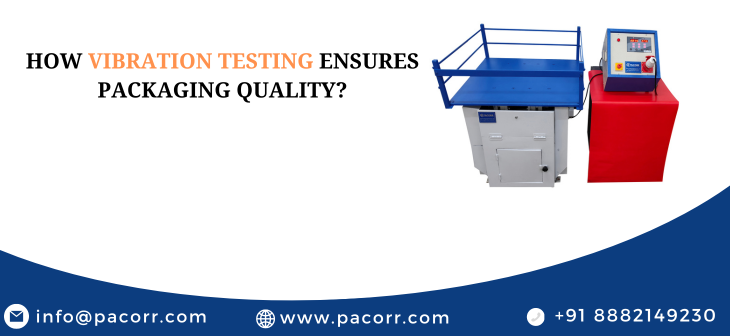
Vibration testing, particularly through the use of sophisticated equipment like vibration tables, plays a critical role in this process. This article explores how vibration testing ensures packaging quality, discussing the relevance of standards such as ASTM D-999, TAPPI T-817-pm, and IS7028 (part II) and highlighting the significance of instruments like the Vibration Table offered by Pacorr.
The Critical Need for Vibration Testing
Vibration testing assesses the durability of packaging by simulating the conditions that products are likely to encounter during transit. This form of testing is crucial for identifying potential vulnerabilities in packaging materials and structures, thereby preventing damage during shipping. Ensuring that packaging can withstand these conditions is essential not only for product safety but also for customer satisfaction and brand reputation.
Understanding Vibration Tables
A vibration table is an instrumental tool in this testing process. It generates controlled vibrations, mimicking the dynamic forces that packages face during transportation. Pacorr’s Vibration Table, for instance, is designed for precision and efficiency, equipped with features that allow for specific frequency and amplitude adjustments necessary to conduct rigorous and reliable tests.
Standards and Compliance
Compliance with established testing standards is fundamental to the process. Standards like ASTM D-999 specify the methods for conducting vibration tests, ensuring consistency and reliability across tests. These standards are designed to replicate real-world conditions as closely as possible, providing confidence in the results and the methods used.
Practical Applications
In practical terms, vibration testing allows manufacturers to:
- Evaluate the resilience of packaging designs.
- Optimize material selection and structural designs to enhance protection.
- Comply with regulatory requirements and meet industry standards.
- Reduce the risk of damage during shipping, thus decreasing the likelihood of returns and increasing customer satisfaction.
Benefits of Pacorr’s Vibration Table
Pacorr’s Vibration Table stands out due to its robust design and advanced features, which include:
- Adjustable frequency range to simulate different transport scenarios.
- High load capacity to accommodate various product sizes.
- Digital controls for precise testing adjustments.
- Compliance with international standards like ASTM D-999.
The table’s capabilities allow manufacturers to conduct thorough and effective tests, ensuring that their products are well-protected against the rigors of transportation.
The Role of Standards in Vibration Testing
Adhering to standards like ASTM D-999, TAPPI T-817-pm, and IS7028 (part II) is not just about regulatory compliance. These standards guide manufacturers in creating packaging that withstands vibrational forces, ensuring product safety from production to delivery. They provide a framework for testing that is recognized globally, facilitating international trade and export.
Vibration testing is an essential component of the manufacturing and packaging process. It ensures that products can withstand the inevitable stresses of transportation, thereby safeguarding product integrity and customer satisfaction. With advanced tools like Pacorr’s Vibration Table and adherence to strict standards, manufacturers can achieve a high level of quality assurance in their packaging efforts.
Detailed Insights into Vibration Testing Methodologies
1. Role of ASTM D-999 in Vibration Testing
ASTM D-999 provides detailed methodologies for simulating different transport environments. It describes how to adjust vibration tables to match the frequencies and amplitudes that packages might encounter during road, air, or sea transit. This standard is crucial because it ensures that the testing environment realistically mimics actual transportation conditions, thus providing manufacturers with valuable data on how their packaging will perform in real-world scenarios.
2. Application of TAPPI T-817-pm
TAPPI T-817-pm complements ASTM by focusing specifically on the shipping container’s ability to withstand vibrations. This standard is particularly important for industries where products are prone to damage due to internal movement or external forces. It helps manufacturers understand the dynamic responses of fiberboard containers, aiding in the design of more resilient packaging solutions.
3. Incorporating IS7028 (Part II) for Global Standards
IS7028 (part II) is an Indian Standard that aligns with global testing protocols, facilitating international trade. By adhering to this standard, manufacturers can ensure that their packaging not only meets domestic quality requirements but also complies with international safety and quality norms, which is crucial for exporting goods.
Practical Applications and Case Studies
Case Study: Impact of Vibration Testing on Electronics Packaging
A detailed case study could illustrate how an electronics manufacturer used vibration testing to redesign their packaging for sensitive components. Initially experiencing a high rate of returns due to transit damage, the company implemented stringent testing using the guidelines of ASTM D-999 and TAPPI T-817-pm. By simulating various transport conditions and adjusting the packaging design based on the test outcomes, they significantly reduced damage rates and improved customer satisfaction.
Real-World Application in Beverage Industry
In the beverage industry, vibration testing is critical to prevent the mishandling of liquid products. Using Pacorr’s Vibration Table, a well-known beverage company could test their new glass bottle packaging under various simulated conditions. The results led to modifications in the cushioning and boxing techniques, which enhanced the overall sturdiness of the packaging and reduced breakage rates during transit.
Broader Implications and Future Directions
Sustainability and Vibration Testing
As environmental concerns gain traction, there is a growing emphasis on developing sustainable yet durable packaging solutions. Vibration testing is pivotal in this regard because it allows manufacturers to test innovative, eco-friendly materials under rigorous conditions, ensuring they do not compromise on product safety while adhering to sustainability standards.
Technological Advancements in Vibration Testing Equipment
Future advancements in vibration testing equipment, such as the integration of IoT and AI, could revolutionize how tests are conducted and analyzed. These technologies could provide real-time data analysis and predictive insights, helping manufacturers optimize packaging designs more efficiently and with greater precision.
Vibration testing is more than just a procedural necessity; it is a strategic tool in the packaging industry’s quest for quality, safety, and customer satisfaction. With the support of standards like ASTM D-999, TAPPI T-817-pm, and IS7028 (part II), and advanced equipment like Pacorr’s Vibration Table, manufacturers are well-equipped to face the challenges of delivering products in perfect condition to consumers worldwide

